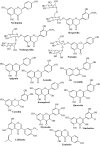Flavonoids are promising safe therapy against COVID-19
- PMID: 34054380
- PMCID: PMC8139868
- DOI: 10.1007/s11101-021-09759-z
Flavonoids are promising safe therapy against COVID-19
Abstract
Flavonoids are a class of phenolic natural products, well-identified in traditional and modern medicines in the treatment of several diseases including viral infection. Flavonoids showed potential inhibitory activity against coronaviruses including the current pandemic outbreak caused by the severe acute respiratory syndrome coronavirus 2 (SARS-CoV-2) and designated as COVID-19. Here, we have collected all data related to the potential inhibitory mechanisms of flavonoids against SARS-CoV-2 infection and their significant immunomodulatory activities. The data were mapped and compared to elect major flavonoids with a promising role in the current pandemic. Further, we have linked the global existence of flavonoids in medicinal plants and their role in protection against COVID-19. Computational analysis predicted that flavonoids can exhibit potential inhibitory activity against SARS-CoV-2 by binding to essential viral targets required in virus entry and/ or replication. Flavonoids also showed excellent immunomodulatory and anti-inflammatory activities including the inhibition of various inflammatory cytokines. Further, flavonoids showed significant ability to reduce the exacerbation of COVID-19 in the case of obesity via promoting lipids metabolism. Moreover, flavonoids exhibit a high safety profile, suitable bioavailability, and no significant adverse effects. For instance, plants rich in flavonoids are globally distributed and can offer great protection from COVID-19. The data described in this study strongly highlighted that flavonoids particularly quercetin and luteolin can exhibit promising multi-target activity against SARS-CoV-2, which promote their use in the current and expected future outbreaks. Therefore, a regimen of flavonoid-rich plants can be recommended to supplement a sufficient amount of flavonoids for the protection and treatment from SARS-CoV-2 infection.
Keywords: COVID-19; Flavonoids; Global distribution; Immunomodulatory; SARS-CoV-2; Treatment.
© The Author(s), under exclusive licence to Springer Nature B.V. 2021.
Conflict of interest statement
Conflict of interestAll authors declared there is no financial interest.
Figures








Comment in
-
Flavonoids and ω3-polyunsaturated fatty acid supplementation in renal transplant recipients: new arguments from COVID-19.J Nephrol. 2022 Jan;35(1):95-97. doi: 10.1007/s40620-021-01194-9. Epub 2021 Nov 13. J Nephrol. 2022. PMID: 34773603 Free PMC article. No abstract available.
References
-
- Abouleish M, El-Keblawy A, et al. Importance of environmental factors on production of computationally—defined natural molecules against COVID-19 pandemic. Curr Top Med Chem. 2020;20:1958–1961. - PubMed
-
- Adem S, Eyupoglu, V, Sarfraz, I et al (2020) Identification of potent COVID-19 main protease (Mpro) inhibitors from natural polyphenols: an in silico strategy unveils a hope against CORONA. preprints.org. - PMC - PubMed
-
- Ahmad A, Kaleem M, Ahmed Z, et al. Therapeutic potential of flavonoids and their mechanism of action against microbial and viral infections—A review. Food Res Int. 2015;77:231–235.
-
- Ali R, Shahid A, Ali N, et al. Amelioration of Benzo[a]pyrene-induced oxidative stress and pulmonary toxicity by Naringenin in Wistar rats: a plausible role of COX-2 and NF-κB. Hum Exp Toxicol. 2017;36:349–364. - PubMed
Publication types
LinkOut - more resources
Full Text Sources
Other Literature Sources
Miscellaneous
